WARSAW UPRISING GOAL: EXPEL NAZI ENEMY
Warsaw, Occupied Poland • July 29, 1944
By July 1944 Poland had been occupied by the armed forces of Adolf Hitler’s Nazi Germany for close to 5 years and by those of Joseph Stalin’s Soviet Union for considerably less. (For nearly 2 years, from September 1939 to June 1941 when the German Wehrmacht invaded the Soviet Union (Operation Barbarossa), the Soviet Army had occupied Western Poland in a devil’s pact between twin dictators Hitler and Stalin that divided Poland down the center.) The Polish resistance Home Army (Armia Krajowa, or AK), 45,000 Warsaw-area irregulars loyal to the London-based Polish government-in-exile, had long planned some form of insurrection against their German occupiers. Led by Lt. Gen. Tadeusz Komorowski, the Home Army initially planned to link up with the invading forces of the Western democracies, which excluded the nefarious Soviet Union fighting alone on Germany’s Eastern Front. However, in 1943, the apocalyptic struggle for Stalingrad marked the beginning of the Axis defeat on the Eastern Front (August 23, 1942, to February 2, 1943) and with the invasion of Western Europe (it would be in Normandy, France) months away, it began to appear that Stalin’s Red Army just might reach the prewar borders of Poland before the armies of the Western Allies did.
On this date, July 29, 1944, in Warsaw’s suburbs, citizens heard the sounds of battle as German forces counterattacked the approaching Soviets. Two days later Soviet forces were on the defensive, or at least appeared to be. Unaware of this, the Home Army launched a revolt against their oppressors. Operation Burza (Tempest) was intended to confront the advancing Soviet armies with Poland’s capital and largest city firmly in the hands of soldiers loyal to Polish Prime Minister Stanisław Mikołajczyk’s Western-backed government in London. From this position of strength, Polish freedom fighters figured a more equitable future for Poland could be assured even if the old set of repressive occupiers were ejected and replaced by a Soviet-sponsored set of Moscow-based communist toadies in a postwar representative government.
Alas, fate could not have dealt Free Polish leaders at home and in distant London a worse set of cards. German forces, including SS (Schutzstaffel) units and Russian mercenaries, ruthlessly put down the 2‑month-long Warsaw Uprising at a cost approaching 25,000 Germans killed, wounded, or missing in action. Some 2,000 German soldiers were Polish prisoners of war. By the time the Home Army capitulated on October 2, upwards of 250,000 Poles had been killed, most of them civilians—a quarter of Warsaw’s population at the time—and 15,000 had been captured. A special unit composed of German professional criminals and SS men on probation—the Dirlewanger Brigade—accounted for 30,000–40,000 of these deaths, which included young children and hospital patients. The Germans ordered the city’s evacuation, and 350,000–550,000 civilians were passed through a transit camp on their way to death, concentration, and work camps or other locations.
The ferocity of AK freedom fighters enraged Germany’s leaders. Adolf Hitler declared, “Warsaw has to be pacified, that is, razed to the ground,” and SS chief Heinrich Himmler issued orders to make Poland’s former capital “completely disappear from the surface of the earth.” Warsaw was to be turned into little more than a military transit station.
The Germans diverted considerable resources to destroying the city. Demolition squads used flamethrowers and explosives to methodically destroy buildings street by street, paying special attention to historical structures, the Polish national archives, and other places of national interest—this under the supervision of German scholars no less. By January 1945, when Warsaw was liberated at the start of a massive new Soviet offensive, roughly 85 percent of the city lay in ruins. The offensive would take the Red Army swiftly across Poland to the former borders of the Reich on January 26, 1945, and to the gates of the Nazi capital on April 16.
Poland’s Warsaw Uprising, August 1 to October 2, 1944
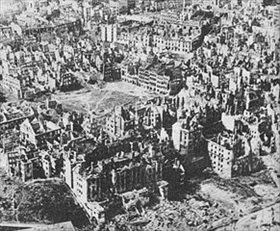 | 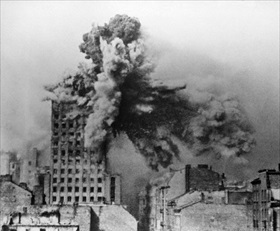 |
Left: An aerial view of Warsaw taken in January 1945. Postwar estimates of material losses were put at 10,455 buildings, 923 historical buildings (94 percent), 25 churches, 14 libraries including the National Library, 81 primary schools, 64 high schools, the University of Warsaw, the Warsaw University of Technology, and most of the city’s historical monuments. Almost a million inhabitants lost all their possessions.
![]()
Right: On August 28, 1944, the Germans used “Moerser Karl,” a self-propelled siege mortar, to fire 2‑ton mortar shells into the Prudential building, Warsaw’s first skyscraper. Smoke from burning and blasted buildings engulfed the city in a grayish-brown haze that reduced visibility to a dozen yards/10 meters.
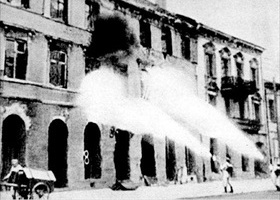 | 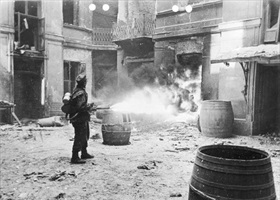 |
Left: During the German invasion of Poland in September 1939, much of Warsaw’s Old Town was badly damaged by the Luftwaffe’s campaign of terror bombing. After the Warsaw Uprising (August 1 to October 2, 1944), what had been left standing was systematically blown up or torched by flamethrowing units of German Army, as shown in this photo. The destruction of Warsaw’s Old Town was so thorough that city fathers resorted to 18th‑century oil paintings and pre-war architectural drawings to guide them in reconstructing the historic district. Warsaw’s New Town, a neighborhood dating from the 15th century, was only partially restored to its former state.
![]()
Right: A German caption accompanying this photo read: “Each nest of insurgents must be individually smoked out. The flames of this flamethrower crushed every instance of resistance that kept popping up from this hard-to-reach cellar.” Not necessarily so everywhere. One German Army intelligence officer who spent most of the war in Warsaw wrote his wife and children: “When streets of houses are deliberately burned down and the civilian population flees somewhere, rebels occupy the rubble and go on firing. Anyone sighted on the streets is shot.” Quoted in Nicholas Stargardt, The German War, p. 436.
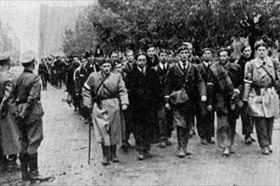 | 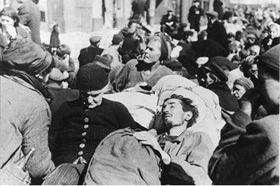 |
Left: Soldiers of the underground Polish Home Army surrender to the German Wehrmacht at a checkpoint in Warsaw, October 5, 1944, 2 days after their leaders had surrendered to the German Army in a formal signing ceremony. According to the agreement, the Wehrmacht promised to treat Home Army soldiers in accordance with the Geneva Convention—granting them combatant status and sending them to POW camps—and to treat the civilian population humanely. But within days the entire civilian population of Warsaw was expelled from the city. Out of a half million evacuees, 90,000 were sent to labor camps in the Third Reich and 60,000 were shipped to death and concentration camps. Of the 28,000 Jews who had somehow succeeded in hiding themselves in the city, fewer than 5,000 survived.
![]()
Right: Sick and starved people emerge from basements and sewers in Warsaw in October 1944, 2 months after the start of the Warsaw Uprising. Some people continued hiding in the deserted city and were called “Robinson Crusoes” or “cavemen.” The Germans called them “rats” and killed them when found. Among the best-known “Crusoes” was Władysław Szpilman (1911–2000), whose best-selling memoir The Pianist was turned into a film of the same name in 2002.
CNN Documentary on Warsaw Uprising: The Forgotten Soldiers of World War II
![]()

 History buffs, there is good news! The Daily Chronicles of World War II is now available as an ebook for $4.99 on Amazon.com. Containing a year’s worth of dated entries from this website, the ebook brings the story of this tumultuous era to life in a compelling, authoritative, and succinct manner. Featuring inventive navigation aids, the ebook enables readers to instantly move forward or backward by month and date to different dated entries. Simple and elegant! Click
History buffs, there is good news! The Daily Chronicles of World War II is now available as an ebook for $4.99 on Amazon.com. Containing a year’s worth of dated entries from this website, the ebook brings the story of this tumultuous era to life in a compelling, authoritative, and succinct manner. Featuring inventive navigation aids, the ebook enables readers to instantly move forward or backward by month and date to different dated entries. Simple and elegant! Click 











